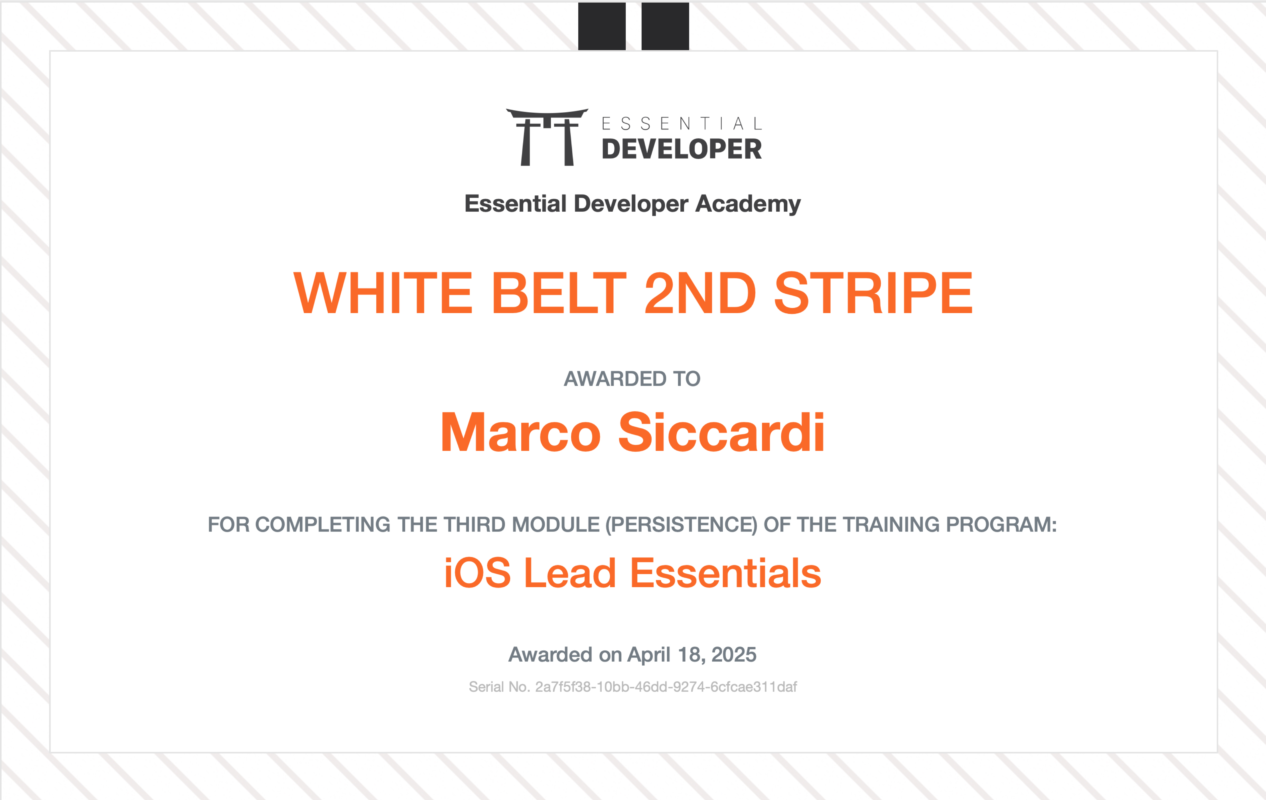Lead Essentials: Persistence Module finished (White Belt 2nd stripe)
After reaching the White Belt 1 stripe in the iOS Lead Essentials program, I’m starting to see how everything I’ve learned so far is beginning to connect. This third module, focused on persistence and system behavior, felt like the moment where theory and practice started to merge.
Understanding Where Data Belongs
It all started with a seemingly simple question: “Where and how should data live in an app?” - From that point on, the module dug into persistence options available in Swift—and more importantly, how to choose between them.
I had already worked with things like UserDefaults, FileManager, and Core Data before—but this time, it wasn’t just about using these tools. It was about understanding why and when to use each one, how to test them effectively, and how to keep their usage clean and maintainable over time.
Putting Persistence into Practice
Working with URLCache, Codable plus the file system, and Core Data became a practical exercise in trade-offs. The course walked through how to persist and retrieve data using each approach and what implications that has for architecture, performance, and testing.
Core Data, in particular, got a deep treatment—everything from modeling entities and managing contexts to dealing with concurrency and writing reliable tests. It was about more than just CRUD operations—it was about doing it right in real-world scenarios.
Concurrency Without the Chaos
Concurrency in Swift is one of those areas that always seems straightforward—until it’s not. This module dove into the details of DispatchQueue, serial vs. concurrent queues, and how to properly use sync, async, and barrier flags.
But beyond the APIs, it challenged me to think more deeply: How do I keep shared state safe? How do I design components that behave correctly under load? I learned how to identify, debug, and prevent race conditions—and how Swift’s value and reference types behave in multithreaded contexts.
Bringing Principles into Practice
As things moved from implementation into design, the course introduced architectural principles that now feel essential. The Composite Reuse Principle (favoring composition over inheritance) took on new meaning through Swift’s protocol-oriented capabilities.
Protocol inheritance, extensions, and conditional conformance all showed how modular, scalable code can be achieved without overly complex hierarchies.
Architecture That Scales with Confidence
Beyond principles, the module also offered architectural strategies that help when projects grow. Decoupling business logic from infrastructure, structuring deterministic logic, breaking monoliths into modules, and using Data Transfer Objects (DTOs) were all covered with practical Swift examples.
Testability From the Ground Up
Testing wasn’t treated as a separate topic. As the course is teaching us everything with a TDD approach, it was built into everything.
I picked up strategies for controlling the environment during tests, measuring and optimizing test time with xcodebuild, and writing fast, stable tests through triangulation. The module also emphasized using real frameworks for integration testing instead of relying solely on mocks.
Building a Maintainable Codebase
Toward the end, the focus shifted to long-term code health. That included practical guidance on producing a clean and stable Git history, flattening hard-to-read nested logic (a.k.a. “arrow code”), and the importance of naming things well—something that’s often overlooked but makes a huge difference in collaboration and clarity.
Wrapping It All Together
This module was dense but incredibly rewarding. It deepened my understanding of how to manage data, deal with concurrency, and design Swift code that’s testable, maintainable, and scalable. A lot of the lessons felt connected to real problems I’ve encountered in the past.
What’s Next?
I’ll continue progressing through the remaining belt levels in the Lead Essentials curriculum. The journey so far has already leveled up my thinking as a developer, and I’m looking forward to level up further as the course progresses.
Click to see the full iOS Lead Essentials curriculum
Disclaimer: This blog post was written with the help of AI, based on a bulleted summary of learning topics provided as part of the Lead Essentials program. The structured list served as the foundation for turning the content into a more readable, narrative-style post that reflects my personal learning experience. I reviewed and edited the post before publishing to ensure it meets the quality standards of this blog.
